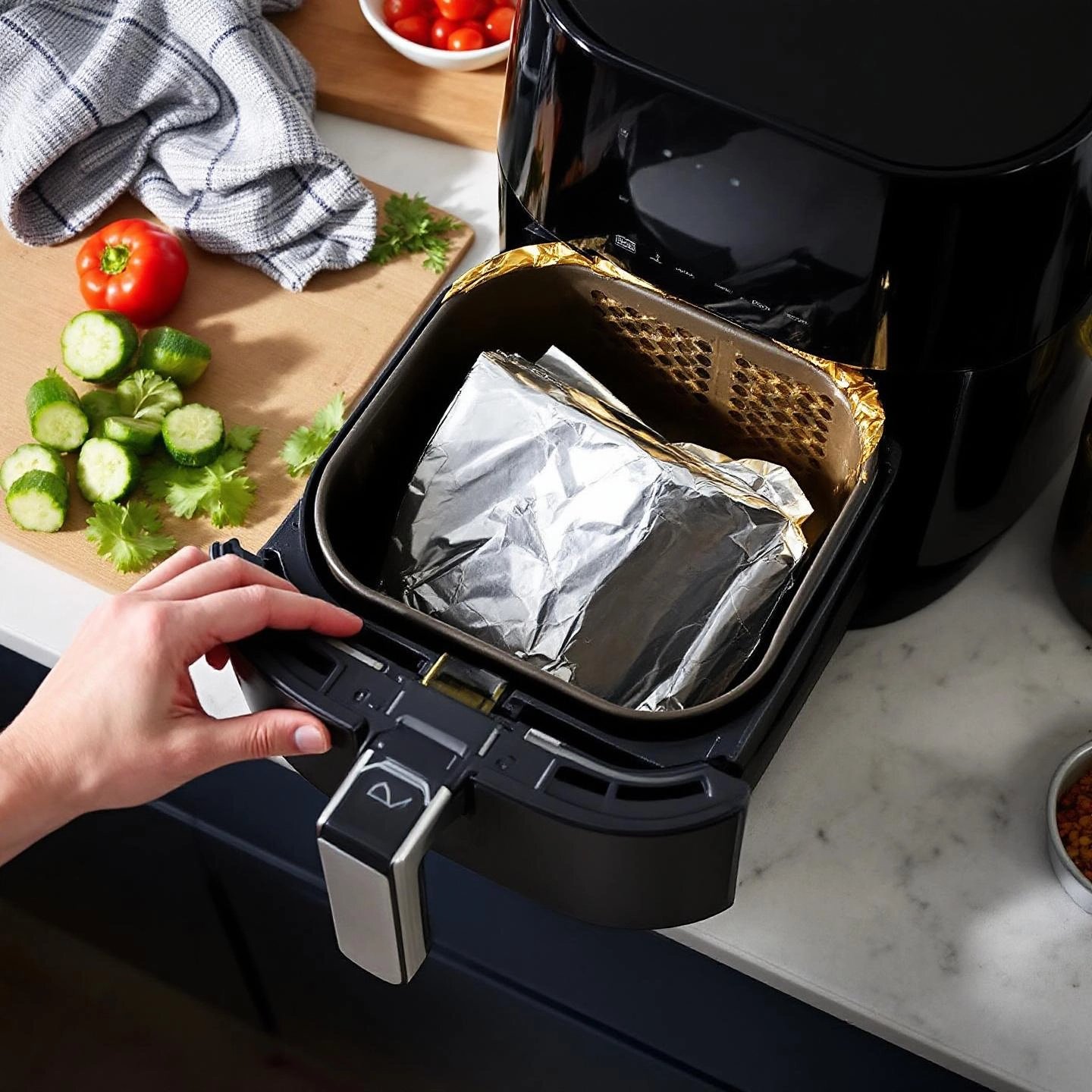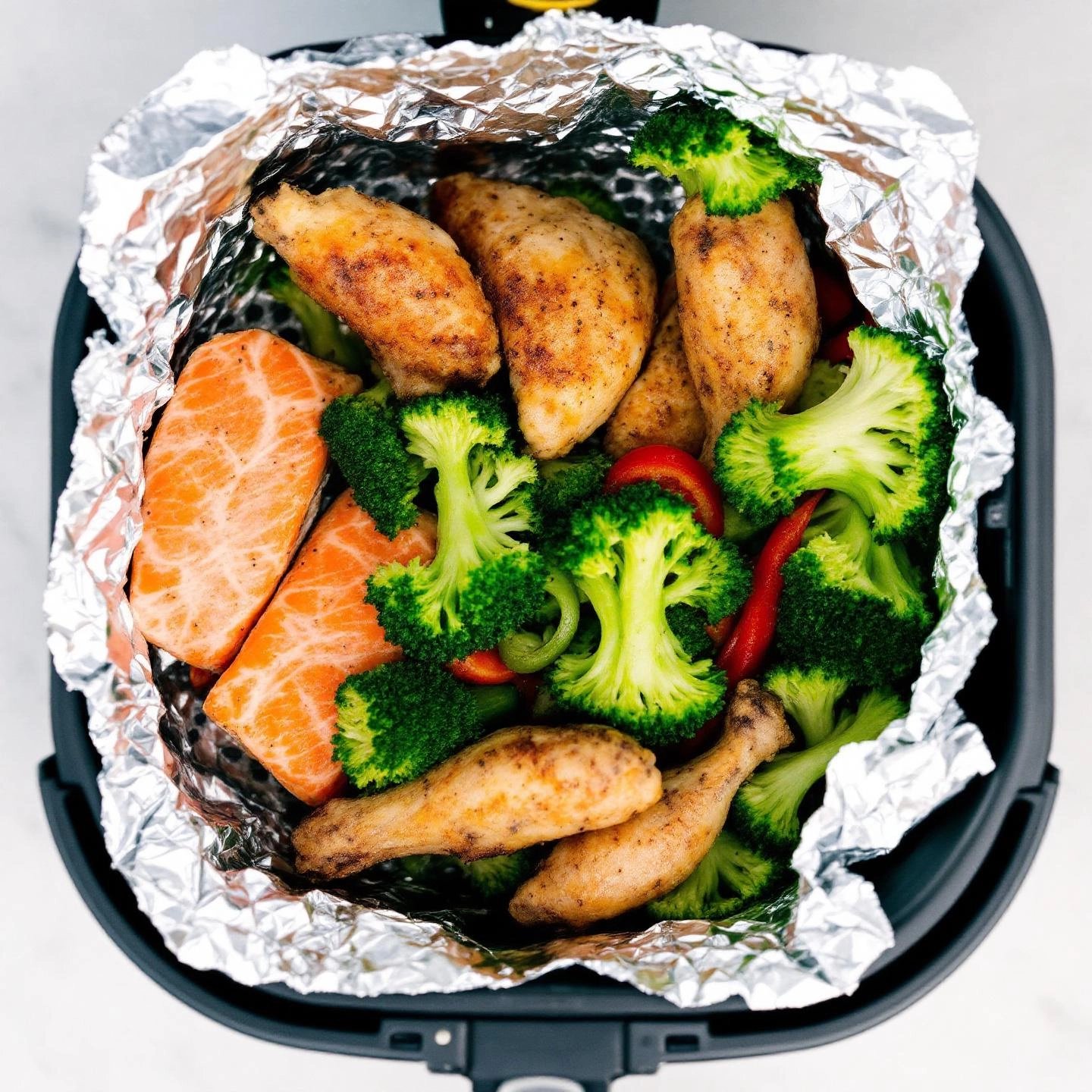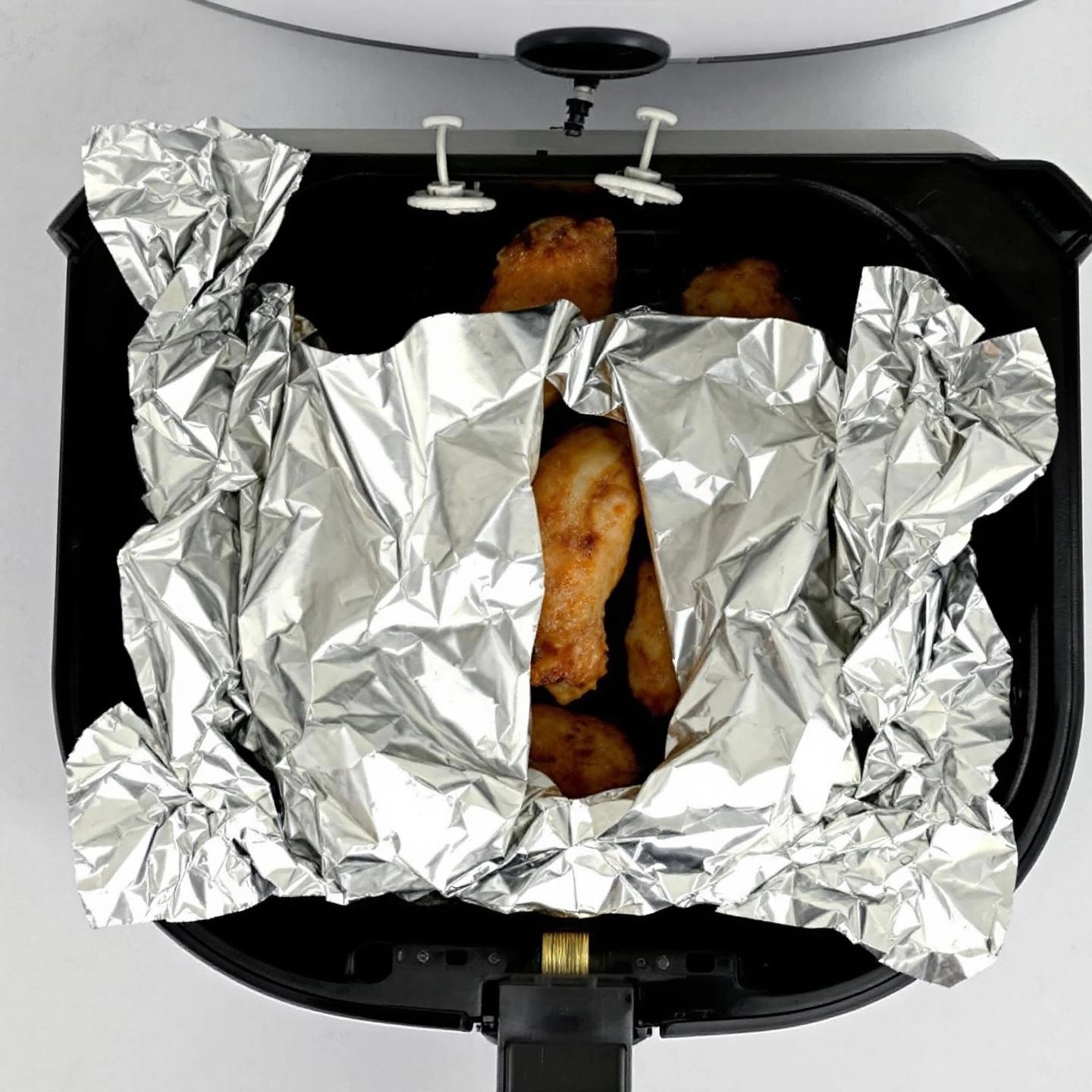
When you think about making quick, crispy meals at home, what appliance comes to mind? For many, the answer is the air fryer. Over the past few years, air fryers have transformed kitchens everywhere, offering a healthier and more convenient way to enjoy everything from golden fries to roasted vegetables. Their popularity keeps rising, thanks to their ability to cook food quickly, use less oil, and deliver that irresistible crunch we all love (market.us).
But as you experiment with new recipes, you might pause and wonder: Can I put aluminum foil in air fryer baskets or trays? It’s a common question—and for good reason. The idea of using foil promises effortless cleanup and could make certain dishes easier to prepare, but there’s often confusion about whether it’s truly safe or effective. You’ve probably seen mixed advice online or even conflicting recommendations in appliance manuals.
Imagine you’re preparing saucy chicken wings or delicate fish. Wouldn’t it be great to use foil to keep things tidy and prevent sticking? Or maybe you’re just looking to save time on washing up. Understanding when and how to use aluminum foil in your air fryer can make a big difference in your cooking routine.
This comprehensive guide is designed to answer all your questions about aluminum foil in air fryer cooking. We’ll explore the safety considerations, highlight the key benefits, and walk you through best practices and practical tips. You’ll also discover alternatives like parchment paper and learn which foods work best with foil. By the end, you’ll feel confident making the most of your air fryer—no more second-guessing or messy surprises.
Wondering, can you put aluminum foil in air fryer baskets or trays? The answer is yes—you can safely use aluminum foil in most air fryers. Just like you might line a baking tray in your oven, using foil in an air fryer is generally considered safe and can offer some real advantages, like easier cleanup and less mess. However, there are a few important rules to keep in mind to ensure you get the best results and keep your appliance running smoothly.
So, is aluminum foil safe in air fryer recipes? Absolutely, as long as you follow these simple guidelines. In the next sections, you’ll discover the main benefits of using foil, plus step-by-step safety and usage instructions for worry-free air frying.

Ever wondered why so many home cooks reach for aluminum foil when air frying their favorite meals? If you’re looking for ways to make cleanup easier, protect your food, or even cook more evenly, you’re not alone. Let’s break down the benefits of aluminum foil in air fryer cooking, so you can decide when it’s the right tool for your kitchen routine.
Imagine roasting salmon on a foil tray or wrapping up leftover pizza for a quick reheat—foil adapts to whatever the recipe calls for. Now that you know why so many cooks rely on foil, let’s dive into the essential safety rules to ensure you’re using it correctly and getting the best results from your air fryer.

Sounds complex? If you’ve ever wondered, is aluminum foil safe in air fryer recipes, you’re not alone. The answer is yes—when you follow a few simple but crucial safety rules. Let’s break down exactly how to use foil without risking your meal, your appliance, or your peace of mind.
Imagine prepping your favorite sticky chicken wings or delicate fish fillets. You want the cleanup to be easy, but you also want your food to cook perfectly. Here’s how to make sure your air fryer experience is both safe and successful:
Not all foil is created equal. Heavy-duty or non-stick aluminum foil is more heat-resistant and less likely to tear, making it a safer choice for air frying tasks. Using high-quality foil ensures better results and less risk—think fewer tears, less sticking, and more reliable performance.
“Only line the basket or wrap the food you need to protect,” recommends air fryer expert Jenny Catton. Too much foil can interfere with the fryer’s convection system, so use it sparingly and purposefully.
For the safest and most effective air frying, opt for high-quality aluminum foil produced by reputable manufacturers. Industry leaders like Shengxin Aluminum are known for their stringent quality standards and advanced manufacturing processes. Using premium foil not only improves your cooking results but also ensures peace of mind—so you can focus on enjoying your meal, not worrying about safety issues.
Ready to put these safety tips into action? Next, let’s walk through the step-by-step process for correctly placing foil in your air fryer basket, so you can cook with confidence every time.
When it comes to using foil in your air fryer, the right technique makes all the difference. Ever found yourself wondering exactly how to put aluminum foil in air fryer baskets without risking uneven cooking or a messy cleanup? Here’s a straightforward, step-by-step guide to help you get it right every time—no guesswork, just great results.
Imagine you’re preparing sticky chicken wings or roasting vegetables—using these steps, you’ll notice how much easier cleanup becomes and how your food cooks more evenly. Next, let’s look at which foods are perfect candidates for this method, so you can put your new skills to use right away.

Ever wondered which meals come out best when you use foil in your air fryer? Imagine prepping a weeknight dinner or warming up leftovers—using foil can make certain dishes easier, tastier, and less messy. Here are some of the best foods to cook with aluminum foil in air fryer baskets or trays, along with tips to help you get delicious results every time.
Next time you’re planning a meal, think about how foil can simplify your process and elevate your results. Now that you know the top foods for this technique, let’s explore which foods and situations are better avoided when using foil in your air fryer.
When you’re eager to simplify cleanup or protect delicate foods, it’s tempting to use foil for everything. But did you know there are certain foods to avoid with aluminum foil in air fryer baskets? Imagine prepping a zesty lemon chicken or tossing in a handful of kale chips—sounds easy, right? However, not all foods and scenarios are a good match for foil. Here’s what you need to know to keep your air frying safe, effective, and delicious.
By steering clear of these foods and scenarios, you’ll protect both your meals and your appliance. Ready to discover the best alternatives for tricky recipes? Up next, we’ll cover when parchment paper is the smarter choice for air frying success.

Ever paused mid-recipe and wondered, "Should I use parchment paper or aluminum foil in air fryer cooking?" If you’ve faced sticky messes or delicate baked goods, you’re not alone. The answer often comes down to the unique properties and best uses of each liner.
So, when should you reach for parchment paper instead of foil? Choose parchment for:
Just remember: always cut parchment to size, weigh it down with food, and avoid exceeding temperatures above 450°F. Next, let’s compare parchment and foil side by side, so you can confidently pick the right liner for any air fryer meal.
When you’re standing in your kitchen, ready to air fry tonight’s dinner, do you ever wonder: “Should I reach for aluminum foil or parchment paper?” The choice can make a real difference in how your food turns out—and how easy cleanup will be. Let’s break down the key differences, so you can confidently pick the best liner for every recipe.
| Feature | Aluminum Foil | Parchment Paper |
|---|---|---|
| Heat Conduction | Excellent conductor—helps brown and crisp food quickly. Ideal for roasting, grilling, or reheating. | Moderate conduction—prevents over-browning, better for baked goods and gentle heat. |
| Non-Stick Properties | Not inherently non-stick (unless labeled). May require oil or spray to prevent sticking. | Naturally non-stick—perfect for cookies, pastries, or cheesy foods. |
| Airflow | Can block airflow if not properly sized or perforated. Always leave gaps or poke holes. | Breathable—especially when pre-perforated or trimmed. Allows even circulation for crispier results. |
| Best Uses | Roasting meats, reheating leftovers, lining for easy cleanup, making foil packs. | Baked goods, sticky or acidic foods, delicate pastries, and recipes requiring a non-reactive liner. |
| Cleanup | Excellent for messy or greasy foods—just lift and toss. Durable for heavy-duty tasks. | Makes removing baked items easy, but not as sturdy for heavy or very moist foods. |
| Reactivity | Reacts with acidic foods (tomatoes, citrus) and may affect taste—avoid in these cases. | Non-reactive—safe for all foods, including acidic recipes. |
| Temperature Limit | Very high—safe for all air fryer temperatures. | Usually up to 450°F—check packaging for specifics. |
So, which is better for your air fryer? If you’re crisping up wings or roasting vegetables, aluminum foil’s heat conduction and durability shine. For cookies, pastries, or anything sticky or acidic, parchment paper’s non-stick and non-reactive qualities win out.
Pro tip: No matter which liner you choose, quality matters. Using high-grade materials—like the precision-crafted aluminum foil from Shengxin Aluminum—ensures safe, consistent results whether you’re cooking at home or in a professional kitchen. With the right liner and a little know-how, you’ll unlock the full potential of your air fryer every time.
Now that you understand the strengths of each option, let’s wrap up with the key takeaways for safe, creative, and confident air frying.
When you’re standing in your kitchen, ready to try a new recipe, you might still wonder, can I use aluminum foil in air fryer meals safely? The answer is yes—when you follow a few essential guidelines. By now, you’ve learned that aluminum foil in air fryer cooking offers real benefits: easier cleanup, better heat distribution, and more versatility for your favorite dishes. But as with any kitchen tool, safety and technique matter most.
Imagine prepping sticky chicken wings or roasting vegetables—using these best practices, you’ll notice just how much easier and more enjoyable air frying becomes. And don’t be afraid to experiment! With your new understanding of aluminum foil in air fryer safety, you can confidently try new meals and techniques, knowing your results will be both delicious and safe.
Finally, remember that the quality of your materials makes a difference. Opting for premium foil from trusted manufacturers—such as Shengxin Aluminum—ensures reliability and peace of mind, whether you’re cooking for your family or prepping meals in a professional kitchen. With the right knowledge and the best tools, your air fryer can become the centerpiece of creative, efficient, and safe home cooking.
Yes, aluminum foil can be safely used in most air fryers as long as it only lines the basket or tray and does not block the appliance's airflow. Always weigh the foil down with food to prevent it from moving and avoid letting it touch the heating element. Check your air fryer manual for specific recommendations.
It's best to avoid using aluminum foil with highly acidic foods like tomatoes or citrus, as these can react with the foil. For sticky or acidic recipes, parchment paper is a safer alternative. Always ensure your food is heavy enough to keep the foil in place.
No, never cover the entire basket with foil. Doing so blocks the hot air circulation that is essential for even cooking and crisp results. Always cut the foil to fit only under your food, leaving plenty of gaps for air to flow.
Aluminum foil makes cleanup easier, can help distribute heat more evenly, and protects delicate foods from sticking or breaking apart. It's also versatile for creating trays or pouches for different recipes.
High-quality foil, such as that produced by reputable manufacturers like Shengxin Aluminum, is more resistant to tearing and heat, ensuring safer and more reliable air frying. Premium materials also help prevent unwanted reactions with food.
 Servicio en línea
Servicio en línea 0086 136 3563 2360
0086 136 3563 2360 sales@sxalu.com
sales@sxalu.com +86 136 3563 2360
+86 136 3563 2360